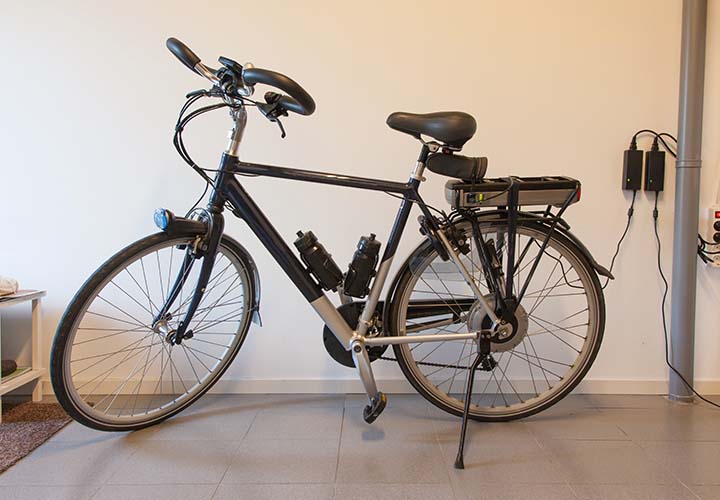An alarming increase in lithium-ion battery-related fires in New York City—specifically e-bikes and e-scooters—has sparked new legislation that is putting city property owners on notice. This new law addresses critical safety issues and outlines a plan to both combat the fires and improve safety standards as they relate to electric mobility usage and storage. Do you own a commercial or residential property in New York City? Read on to learn if you’re in compliance with NYC code regulations to keep your tenants safe.
What you need to know
Milrose Consultants was asked to assess the New York City storage requirements for battery-powered mobility devices in existing facilities. These battery-powered mobility devices include e-bikes and e-scooters. Before we dive into the findings, however, let’s understand the scope of what is considered a battery-powered mobility device. The NYC Fire Code defines these as:
Motorized bicycles, motorized scooters and other personal mobility devices powered by lithium-ion or other storage batteries. The term does not include motor vehicles or motorcycles or other mobility devices that must be registered with the New York Department of Motor Vehicles.
This new 2022 definition extends coverage to non-traditional methods of battery-powered transport, such as hoverboards, segways, electric skateboards, and electric unicycles.
The New York City Building Code defers the storage requirements for battery-powered mobility devices to the 2022 NYC Fire Code, which took effect on April 15, 2022. Here are the specific provisions that address storage requirements:
- Facilities and spaces that are being used to store battery-powered mobility devices that existed prior the enaction of the 2022 NYC Fire Code may continue to do so in the same manner, same number and same type of devices that have historically been housed in such spaces.
- This provision will not apply if the space has been altered, new, different, or an increased number of devices are being stored or the Fire Department of New York (FDNY) amends the current code to add a retroactive provision mandating immediate upgrades.
Triggers for upgrading spaces
The triggers for upgrading existing spaces for the storage of such devices to the full parameters of the 2022 NYC Fire Code are as follows:
- When the part of the building, structure, facility, or premises in which the lawfully existing condition exists undergoes a change in use or occupancy.
- When the part of the building, structure, facility, or premises in which the lawfully existing condition exists undergoes alteration, whether made voluntarily, or as a result of damage, deterioration or other cause.
- When new and/or an increased number of devices are introduced to the part of the building, structure, facility, or premises in which the lawfully existing condition exists.
- If the FDNY commissioner determines such facility or condition constitutes a life safety hazard. (Due to recent unfortunate fire incidents associated with such devices, retroactive requirements for existing facilities could be mandated in the near future.)
If any of the itemized triggers above apply, then the existing facilities would need to be upgraded to comply with the full parameters of the 2022 NYC Fire Code, specifically FC Section 309.3, which carries specific limitations on the number and type of devices that can be stored as well as the protection requirements for such spaces used to store these devices.
Why the law was enacted
Thousands of New York city residents rely on e-bikes and e-scooters as affordable alternatives to cars. These convenient modes of transportation, however, have become a dangerous and significant problem for the city as the lithium-ion batteries that power these electric micromobility (or e-micromobility) devices are catching fire—and sometimes exploding—causing serious injury and even death. As of this writing, in New York City alone, lithium-ion batteries from e-bikes have caused 92 fires, which injured 64 people. An additional nine people were killed. This figure surpasses the number of lithium-ion-related deaths in 2021 and 2022 combined. These fires are extremely dangerous. They spread quickly, are difficult to extinguish, and produce noxious fumes.
A new plan for a safer city
Last March, New York City Mayor Eric Adams announced the “Charge Safe, Ride Safe: New York City Electric Micromobility Action Plan” for safer e-micromobility. Since lithium-ion batteries are the culprits behind these dangerous fires, the new law requires strict certification processes of all electric bicycles, electric scooters, and lithium-ion batteries. Here are the four pillars which the plan focuses on:
- Supporting New Yorkers’ transition to safe and legal e-micromobility use
- Increasing education and outreach about safe device usage
- Bolstering regulation and enforcement against illegal device usage
- Promoting the growth of safe e-micromobility and cycling
To further regulate the sale of lithium-ion batteries in New York City, Adams signed an additional five bills into law to strengthen fire safety-related battery fires.
Bikes in Buildings Program
Since 2009, the Bikes in Buildings Program has been an advocate for New York City bicycle commuters. This program provides secure bicycle parking during the day and indoor parking to over 13,000 bicycles in nearly 400 commercial buildings. As it relates to battery-powered mobility devices, Milrose confirmed with the NYC Department of Transportation that the program—which gives both employees and tenants of commercial structures the legal right to compel building management or ownership to provide on-site bike storage facilities upon request—applies only to human-powered devices and does not apply to battery-powered mobility devices. This essentially gives employers and landlords legal standing to refuse requests by employees and/or tenants for storage facilities of such devices to be provided on site.
Have questions about the new requirements? We invite you to connect with us today to learn more about our services in the New York area as well as throughout the U.S.







